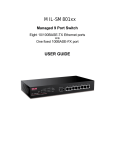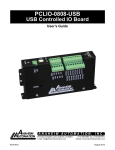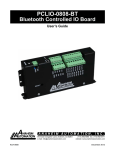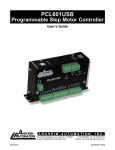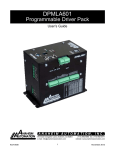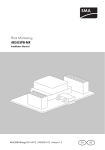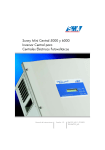Download Asante FM2017 User`s manual
Transcript
FriendlyNET® FM2017 SNMP/Web Managed Switch with Fiber Option User’s Manual 2 Table Of Contents Chapter 1. Introduction Features Ethernet Switching Technology Management Methods Chapter 2. Hardware Installation Package Contents Front Panel Rear Panel Mounting Configurations Powering on the Switch Optional FX100 Modules Chapter 3. Network Application Small Workgroup Segment Bridge VLAN Application Chapter 4. Network Configuration Connecting a Terminal or PC to the Console Port Assigning IP Address Secured IP Chapter 5. Web-Based Management System Login Appendix A. Troubleshooting Appendix B. Internet Explorer Setting Appendix C. Specifications and Warranty Statement 5 5 6 6 7 7 7 8 8 8 8 11 11 11 11 13 13 14 15 17 17 23 25 27 3 4 Chapter 1. Introduction Thank you for purchasing an Asanté FriendlyNET FM2017 SNMP/Web managed switch. This switch is designed to build high-performance switched networks. It uses store-and-forward technology, providing low latency for high-speed networking, and is targeted at workgroup, department or backbone computing environments at small to medium enterprise businesses. The switch features full plug-and-play installation. LED indicators provide for easy monitoring of switch operation. The switch has 16 auto-sensing 10/100 BaseTX Fast Ethernet RJ-45 ports plus one extension slot for an optional 1-port 100BaseFX fiber module, which makes it easy to connect to a remote site up to 2 Km (multi-mode) or 15-60 Km (single-mode) away. The following types of fiber connectors are available for use with the FM2017: SC, SC single-mode, MT-RJ and VF-45. The switch provides automatic MDI/MDIX crossover for each 10/100Mbps port. In general, MDI means connecting to another hub or switch while MDIX means connecting to a workstation or PC. Auto MDI/MDIX means that you can connect to another switch or workstation without changing non-crossover or crossover cabling. There is a CPU module on the rear panel of the switch. It provides the function of Web-Based Management, for ease of managing and configuring the FM2017. From cabinet management to port-level control and monitoring, you can visually configure and manage your network via your web browser. The switch can also be managed via third-party SNMP Management. Features The FriendlyNET FM2017 Fast Ethernet switch has the following features: Compact size — designed for small to medium workgroups in space-limited areas; installs on desktop, or in a standard 19-inch equipment rack Plug-and-play installation Provides 16 auto-negotiating 10/100Mbps RJ-45 ports N-Way auto-negotiation on all ports automatically senses port speed (10/100Mbps) and negotiates duplex mode (full-duplex or half-duplex) Automatic MDI/MDIX crossover for each 10/100 port Supports CPU expansion slot to upgrade SNMP function Complies with IEEE 802.3 Ethernet, IEEE 802.3u Fast Ethernet and IEEE 802.3x flow control (in full-duplex mode) standards Provides power, 100M, full- or half-duplex, and link/activity LEDs to aid network diagnosis and simple management Ideal for deployment with high-speed servers, dedicated bandwidth (10Mbps or 100Mbps) workgroups, or as a segmentation device for larger congested networks 8K-entry MAC address table and automatic address learning 4MB packet buffer sharing Performs non-blocking data transfer at full wire speed Intelligent Management Features Web-based management SNMP Network management Supports up to 17 VLAN groups MIB II (RFC1213) supported Port Configuration management Port Disable/Enable Setting Auto-negotiation, 100M Full/half-duplex or 10M Full/half-duplex mode 5 Ethernet Switching Technology Ethernet switching technology has dramatically boosted the total bandwidth of a network, eliminating congestion problems inherent with Carrier Sense Multiple Access with Collision Detection (CSMA/CD) protocol, and has greatly reduced unnecessary transmissions. This revolutionized networking in the following ways: First, by allowing two-way, simultaneous transmissions over the same port (Full-duplex mode), which essentially doubled the network bandwidth; Second, by reducing the collision domain to a single switch-port, which eliminated the need for carrier sensing; Third, by using the store-and-forward technology’s approach of inspecting each packet to intercept corrupt or redundant data, switching eliminated unnecessary transmission that slows the network; Finally, by employing address learning, which replaced the inefficient receiving port. Auto-negotiation regulates the speed and duplex of each port, based on the capability of both devices. Flowcontrol allows transmission from a 100Mbps node to a 10Mbps node without loss of data. Auto-negotiation and flow-control may require disablement for some networking operations involving legacy equipment. Disabling the auto-negotiation is accomplished by fixing the speed or duplex of a port. Ethernet switching technology has supplied higher performance at costs lower than other solutions. Wider bandwidth, no congestion, and the reduction in traffic is why switching is replacing expensive routers and inefficient hubs as the ultimate networking solution. Switching brought a whole new way of thinking to networking. Management Methods The FM2017 supports configuration and management via a Web-browser or via SNMP Management. For more information on configuring and managing your switch, please see Chapters 4 and 5. Console and Telnet Connection Console Connection is done through the RS-232 Console Port. Managing the switch in this method requires a direct connection to a PC, while Telnet management is done over the network. Once the switch is on the network, you can use Telnet to Log in and change the configuration. Web-Based Management The switch provides an embedded HTML web site residing in flash memory. It offers advanced management features and allow users to manage the switch from anywhere on the network through a standard browser such as Microsoft Internet Explorer or Navigator. For more information, see Chapter 5. Web-Based Management. SNMP Network Management SNMP (Simple Network Management Protocol) provides a means to monitor and control network devices and report activity in each network device to manage configurations, performance, and security. This switch provides up to 4 IP addresses for the access of trap managers. You can submit community strings on getcommunity, set-community and trap-community to authorize management access. 6 Chapter 2. Hardware Installation This chapter describes the front and rear panels of the FM2017, and explains how to install, mount and apply power to the switch. Package Contents The switch is shipped with the following items: • • • • • • Switch AC power cord Four (4) Rubber feet Rack mount Kit RS-232 cable User’s Manual (this document) Compare the contents of your switch’s package against the items listed above. If any of the items is missing or damaged, contact your dealer immediately for service. Front Panel The front panel of the FM2017 contains the LED Indicators, the console port, the 16 10/100Mbps ports and the 100FX module slot. LED Indicators The LED Indicators give real-time information of systematic operation status. The following table provides descriptions of LED status and their meaning. LED Power Status Green Description Power is on. 100M Off Green Power is not connected, or is turned off. A valid 100Mbps link has been established on the port. Link/Activity Off Green A 10Mbps link has been established on the port, or no device is detected. A valid connection to another device has been established on the port. Blinking Traffic is detected on the port (transmitting or receiving). Off Yellow No device is attached. The port is operating in full-duplex. Blinking The port is operating in half-duplex. Off No device is attached, or the port is in half-duplex mode. Full-Duplex 7 Rear Panel The rear panel contains the Network Management module and the 3-pronged power plug. The switch uses AC in the range of 100-240V AC, 50-60Hz. The Network Management module holds the Flash memory, and has two LEDs: CPU Fail: The CPU Fail LED is lit when the switch’s self test and initialization are in progress, after powering on or rebooting the switch CPU Activity: The CPU Activity LED is lit when the switch is displaying network management information Mounting Configurations This section describes how to mount the switch on a desktop or install it in an equipment rack. Desktop Mounting To mount the switch on a desktop or shelf: 1. 2. Attach the four rubber feet (supplied) to the bottom of each corner on the switch. Place the switch on a flat, stable, horizontal desktop or shelf. Make sure you allow enough ventilation space between the switch and surrounding objects. The switch is ready for power and network connections. Rack Mounting The switch can be mounted in a standard 19-inch equipment rack. This rack can be placed in a wiring closet with other equipment (mounting kit supplied). To install the switch in an equipment rack: 1. 2. Attach mounting brackets on each side of the chassis. Mount the switch in the equipment rack by screwing the mounting brackets to the equipment rack. The rack mounting is complete. The switch is ready for network connections. Powering on the Switch The switch may be turned on with or without LAN segment cables connected. To power on the switch: 1. 2. Connect one end of the power cord (supplied) into the AC power connector on the back panel of the switch. Connect the power cord into the plug on the rear panel of the switch, and plug the other end into a local power source outlet. The unit will power on. Optional FX100 Modules This section introduces the optional 100FX modules (sold separately) that can be installed on the front panel of the switch. The following module models are available: 8 • • • • FX100-MMC FX100-SMC15 FX100-SMC30 FX100-SMC60 The FX100 modules are designed to extend the allowable distance between the switch and other network devices. The maximum distance that can be achieved with fiber cabling is 2 kilometers (multi-mode fiber) and up to 15, 30 or 60 kilometers (single-mode fiber). Front Panels The front panels of the FX100 modules consist of LED indicators, two thumbscrews, a DIP-switch for half and full-duplex mode (full-duplex is the default) and one fiber port. Note: Another DIP-switch is found on the module’s board to enable or disable Flow Control (enabled is the default). Module LED Indicators The LED indicators provide real-time information of systematic operation status. The following table provides descriptions of LED indicators on the modules, and their meanings. LED TX Status Blinks Description The port is transmitting data. RX Off Blinks No data is being transmitted. The port is receiving data. Link Off Green No data is being received. A valid link has been established on the port. Off Yellow No link has been established on the port. The port is operating in full-duplex mode. Blinking Yellow The port is operating in half-duplex. Off No link has been established on the port, or the port is in half-duplex mode. FullDuplex Installing an FX100 Module Follow the steps below to install the FX100 modules: Important! Before beginning the installation of a module, disconnect the power from the switch. The FX100 modules are NOT hot-swappable! 1. 2. 3. 4. 5. Unscrew the blank bracket from the front of the fiber port, using the thumbscrews, and set aside. Align the bottom of the module with the guides on the inside of the port. Slide the module into the port until it stops. Press firmly until you feel the module snap into place. Never force, twist or bend the module. Gently push the thumbscrews in and turn clockwise to tighten. Be careful not to over-tighten the thumbscrews. Power on the switch (it will automatically detect the FX100 module). Plug the fiber cable connector into the FX100 module, and connect the other end into a network device. Check the LEDs to verify that there is a link established on the port. 9 10 Chapter 3. Network Application This section provides a few samples of network topology in which the switch can be used. In general, the switch is designed to be used as a segment switch. That is, with its large address table (8000 MAC address) and high performance, it is ideal for interconnecting networking segments. You can use the switch to connect PCs, workstations, and servers to each other by connecting these devices directly to the switch. The switch automatically learns nodes addresses, which are subsequently used to filter and forward all traffic based on the destination address. The switch can connect with another switch or hub to interconnect each of your small, switched workgroups to form a larger switched network. Meanwhile, you can also use fiber ports to connect switches. The distance between two switches via fiber cable can be up to 2 kilometers (multi-mode fiber) or 15~60 kilometers (single-mode fiber). Small Workgroup The switch can be used as a standalone switch to which personal computers, servers or printer servers are directly connect to form a small workgroup. Segment Bridge For enterprise networks where large data broadcasts are constantly processed, this switch is an ideal solution for department users to connect to the corporate backbone. For example, two Ethernet switches, both with PCs and/or a print server, and a local server can all connected to the FM2017. All of the devices in this configuration can communicate with each other through the FM2017. Connecting a server to the switch allows other users to access that server’s data. VLAN Application A Virtual Local Area Network (VLAN) logically segments the physical LAN so that packets are switched only between ports within the same VLAN group. This creates secure segments, as well as enables efficient traffic separation, provides better bandwidth utilization and alleviates cabling issues. You can group the switch ports into broadcast domains by assigning them to the same VLAN group to increase network capacity and performance. Moreover, VLAN groups can be modified at any time to add, move or change users without any re-cabling (for more information, see Chapter 5. Web-Based Management). 11 12 Chapter 4. Network Configuration This chapter explains how to configure console management via a direct connection to the console port of the switch. Console management involves the administration of the switch via a direct connection to the RS-232 console port. This port is a female DB-9 connector. From the main menu of the console program, the user has access to manage the functions of the switch. Connecting a Terminal or PC to the Console Port The console configuration (out-of-band management) allows you to enable a user at a remote console terminal to communicate with the switch as if the console terminal were directly connected to it. Use the supplied RS-232 cable to connect a terminal or PC to the console port. The terminal or PC to be connected must support the terminal emulation program. After the connection between switch and PC is finished, turn on the PC and run a terminal emulation program or Hyper Terminal to match the following default characteristics of the console port: Baud Rate: 9600 bps Data Bits: 8 Parity: None Stop Bit: 1 Control flow: None Note: When setting up the Hyper Terminal, set the Emulation Mode to “VT100”. After you have finished setting the parameters, press OK and then press Enter. The Main Menu of the console management program appears in the emulation program’s window. 13 ---<<Current configuration>>---------------------------[1.0(beta 2)]---[MAC=00:00:94:D1:1C:22] [IP=192.168.0.1] [mask=255.255.255.0] [broadcast=255.255.255.255] [gateway=0.0.0.0] -----------------------------------------------------------------------1. boot-method = [flash] 2. ip-address = [192.168.0.1] 3. subnet mask = [255.255.255.0] 4. broadcast = [255.255.255.255] 5. gateway = [0.0.0.0] 6. traps=[0.0.0.0] [0.0.0.0] [0.0.0.0] [0.0.0.0] 7. get-community = [public] 8. set-community = [private] 9. trap-community = [public] A. sys-contact = [The contact person for this agent] B. sys-name = [The administrative name of the agent] C. sys-location = [The Physical location of the agent] D. Telnet server = [on] E. Http server = [on] F. Telnet/Http username = [root] G. Telnet/Http password = [enabled] H. reboot I. logout J. ping K. help L. loaddefault M. securedip = [0.0.0.0],[0.0.0.0],[0.0.0.0] >>>> Assigning IP Address After you have attached a terminal or PC with emulation software, you are ready to make a connection using a web browser. You first have to assign an IP address to the switch. Once you have logged into the switch, you need to assign an IP address to the switch’s Ethernet Interfaces so that you can connect to the switch using a web browser. If you want to change from the default IP address (192.168.0.1), for example, there are three kinds of commands to choose from. After the symbol >>>>, type in: 1. 2. 3. 1. 2. 3. 4. 5. 6. 7. 8. 9. A. B. C. D. 14 “ip-address xxx.xxx.xxx.xxx” (where the x’s represent an IP address from your network). “2 xxx.xxx.xxx.xxx “. “ip xxx.xxx.xxx.xxx“. boot-method = [flash] ip-address = [192.168.0.1] subnet mask = [255.255.255.0] broadcast = [255.255.255.255] gateway = [0.0.0.0] traps=[0.0.0.0] [0.0.0.0] [0.0.0.0] [0.0.0.0] get-community = [public] set-community = [private] trap-community = [public] sys-contact = [The contact person for this agent] sys-name = [The administrative name of the agent] sys-location = [The Physical location of the agent] Telnet server = [on] E. Http server = [on] F. Telnet/Http username = [root] G. Telnet/Http password = [enabled] H. reboot I. logout J. ping K. help L. loaddefault M. securedip = [0.0.0.0],[0.0.0.0],[0.0.0.0] >>>> Press H to reboot the switch after making your change. Press Enter twice, and the new IP address will now be displayed. By the similar methods, you can configure the Subnet Mask (Default subnet mask is 255.255.255.0), Broadcast (Default Broadcast is 255.255.255.255), and Default Gateway (Default Gateway is 0.0.0.0). The gateway address is the router that can forward packets to the other IP networks. Note: After you finish configuring the above settings, you must execute H (reboot) command to take effect. Afterwards, you can use the J (Ping) command to check whether the network setting has finished or not. Secured IP Secured IP can guard against unauthorized users gaining access to your network configurations. You can allow up to three IP addresses to have access to the switch via telnet or a web browser. The default Secured IP is 0.0.0.0 for all three entries, which means that no network security on IP was set from original factory setting. Type in “M 1 xxx.xxx.xxx.xxx” after the symbol >>>> and press Enter twice in order to set the first secured IP (where the x’s stand for the desired IP address from your network). Then only the end station with IP address that you set has access to the network management and configuration. 6. traps=[0.0.0.0] [0.0.0.0] [0.0.0.0] [0.0.0.0] 7. get-community = [public] 8. set-community = [private] 9. trap-community = [public] A. sys-contact = [The contact person for this agent] B. sys-name = [The administrative name of the agent] C. sys-location = [The Physical location of the agent] D. Telnet server = [on] E. Http server = [on] F. Telnet/Http username = [root] G. Telnet/Http password = [enabled] H. reboot I. logout J. ping K. help L. loaddefault M. securedip = [0.0.0.0],[0.0.0.0],[0.0.0.0] >>>> M 1 xxx.xxx.xxx.xxx Repeat the process for the other two addresses, if desired. 15 16 Chapter 5. Web-Based Management This section introduces the configuration and functions of the web-based management of switch. The FM2017 provides an embedded HTML website residing in the CPU module. It offers management features and allows users to manage the switch from anywhere on the network through a standard web browser. System Login 1. 2. 3. Launch your web browser. Enter the IP address of the switch in the URL window (http://192.168.0.1). Then press Enter. Then the following Welcome screen appears. 4. Click Login button, then the Password Dialogue Box appears. 5. 6. Type in your User Name and Password (the default is “root” for both). Press Enter or click OK. The System screen appears. 17 Inside the System page, the following information about the switch is listed: Network Setting • • • • IP address: 192.168.0.1 Subnet Mask: 255.255.255.0 Broadcast: 255.255.255.255 Default gateway: 0.0.0.0 The configuration above is only a reference setting. If you want to reset or change the numbers, you can click Agent Config to change or reset them. System Group • • • • • SysDescription: Lists the switch name and firmware version number SysUpTime: Lists the time elapsed since powering on the switch SysContact: Enter the name of the person to contact if there are problems with the switch SysName: Enter a name for the switch SysLocation: Enter the switch‘s location; for example, “MIS Department” Remember to click Apply after entering any new information. Statistics Screen The Statistics page displays the detailed information on network traffic for each Ethernet port and the fiber port. 18 The data is automatically updated at regular intervals. Port Config Screen You can use the Port Config page to disable/enable each port. By default, all the ports are Enabled. To disable or enable a port: 1. 2. 3. Select the drop-down menu in the Status column. Choose the status you want for each Ethernet and Fiber port. Remember to click Apply button after finishing your new settings. Speed Config Screen In the Speed Config page, you can manually configure the speed and duplex of each port in order to match any attached devices. 19 To set these parameters for a port: 1. 2. 3. Select the drop-down menu in Speed/Duplex column. Select one of the following choices: Auto/flow control enabled, Auto/flow control disabled, 100BaseTx/Full Duplex, 100Base-Tx/Half Duplex, 10Base-T/Full Duplex or 10Base-T/Half Duplex. Click Apply. VLAN Screen A VLAN (Virtual LAN) is a group of switch ports designated by the switch as belonging to the same broadcast domain. This feature allows workgroups to be defined on the basis of their logical location instead of their physical location, and does not require recalling. VLANs also enable you to configure port-based VLANs to help isolate broadcast traffic and increase security. In this VLAN page, you can create VLAN groups by clicking the check boxes for each desired Port number across from each Group number (by default, all ports are in VLAN Group 1). Click Apply at the bottom of the VLAN page for your configuration to take effect. 20 Agent Config Screen In the Agent Config page, the switch’s current configurations are displayed. You can refer to the following Agent Config page for your own setting. Boot Method There are three modes of Boot Method: • • • FLASH: Boot your system by flash settings. Flash memory resides in a chip and holds its content without power. Software images can be stored, booted and rewritten as necessary BOOTP: Boot your system from BOOTP server (Bootstrap Protocol). A TCP/IP protocol used by a diskless workstation or network computer to obtain its IP address and other network information such as server address and default gateway DHCP: Boot your system from DHCP server (Dynamic Host Configuration Protocol). Software automatically assigns IP addresses to client stations logging onto a TCP/IP network SNMP Management You can manage the switch using a third-party SNMP (Simple Network Management Protocol) agent. Access rights to the SNMP agent are controlled by community strings. The switch provides up to 4 IP addresses for the access of trap managers. You can submit community strings on GetCommunity, SetCommunity and TrapCommunity to authorize management access. The default community strings for the above three items are all public. For security, you should change them to prevent unauthorized access. GetCommunity: (Read-only access) means that a member of community can view the information but cannot make changes to the configuration. SetCommunity: (Read/Write access) allows the member of the community to view and make changes to the configuration. TrapCommunity: (Read/Write access) allows a manager to receive trap events (alarms). 21 Default Agent Configuration The following are the default values of the Agent Config of the switch. You can change the information listed by entering new information (for example, you can change the switch’s IP address by directly typing in a new IP address). Click Apply after entering the information. • • • • • • • • • • • • • • • • • • • Boot-Method: flash IP address: 192.168.0.1 Submask: 255.255.255.0 Broadcast: 255.255.255.255 Gateway: 0.0.0.0 Trap1: 0.0.0.0 Trap2: 0.0.0.0 Trap3: 0.0.0.0 Trap4: 0.0.0.0 GetCommunity: public SetCommunity: public TrapCommunity: public Telnet-Server: on HTTP-Server: on Telnet /Http-Username: root Telnet /Http-Password: root Secured_IP1: 0.0.0.0 Secured_IP2: 0.0.0.0 Secured_IP3: 0.0.0.0 After you have finished entering the new settings for Boot-method, IP Address, Submask, Broadcast and Gateway, remember to click Reboot Agent to have your changes take effect. 22 Appendix A. Troubleshooting This section is intended to help you solve the most common problems on the switch. If you still are having problems after reading through the information here, contact Asanté’s Technical Support for assistance. Your switch can easily be monitored through the LED indicators to assist in identifying problems. Below are listed common problems that you may encounter and where you can find possible solutions. Incorrect Connections When connecting to another switch or hub, you must use a crossover cable from an RJ-45 MDIX connector on your switch to a MDIX connector on the other switch/hub. If you have a straight-through cable, the connection will not work. LAN adapters in end nodes are normally wired as MDI ports, as are some ports on switches or hubs. For connections from the switch to these MDI ports, use a straight-through cable. Faulty or Loose Cables Look for loose or obviously faulty connections. If the cabling appears to be all right, make sure the connections are snug. Finally, try the connection with a known working cable. Non-Standard Cables Non-standard and incorrectly wired cables can cause numerous network collisions and other network problems, seriously impairing network performance. Asanté recommends UTP Category 5 or better UTP cable for every network installation. Improper Network Topologies Make sure that a valid network topology is employed. Common topology faults include excessive cable length, too many repeaters (hubs) between end nodes, and data path loops. Between any two nodes, there should only be one active cabling path at any time. Data path loops will cause broadcast storms that will severely impact network performance. Cabling RJ-45 ports: Use unshielded twisted-pair (UTP) or shield twisted-pair (STP) cable for RJ-45 connections: Category 3, 4 or 5 cable for 10Mbps connections or Category 5 cable for 100Mbps connections. Also be sure that the length of any twisted-pair connection does not exceed 100 meters (328 feet). 100Base-FX fiber port: Fiber multi-mode connector type must use 50/125 or 62.5/125 um multi-mode fiber cable. You can connect two devices over a 2-kilometer distance. However, fiber single-mode connector type must use 9/125 um single-mode fiber cable. You can connect two devices over a15~60-kilometer distance in full-duplex operation. 23 24 Appendix B. Internet Explorer Setting If you are using Internet Explorer, you have to modify the browser setting to enable Java applets to use network ports. We used Internet Explorer 5.0 for the following demonstration. First, select ”Internet Optional..” under “Tools” of the function bar, then follow the step-by-step instructions below. 1. 2. Select the Security tab. Click Trusted sites. 3. Click Sites. 4. Add the IP address (http://192.168.0.1) of the switch to the zone, and then click Add. 5. Disable left-bottom box Require server verification for all sites in this zone, then click OK. 25 6. Go back to Internet Options, then click Custom Level. 7. 8. Scroll down to find Java. Select Custom under Java and click Java Custom Settings. 9. Select the Edit Permissions tab. 10. Select Enable under Unsigned Content, and then press OK. 26 Appendix C. Specifications and Warranty Statement FriendlyNET FM2017 Specifications Standards Protocol Maximum Forwarding Rate LED Indicators Copper Network Cables Fiber Link Maximum Distance Interface Dimensions Operational Temperature Storage Temperature Operational Humidity External Power Supply Power Consumption EMI Safety Limited Warranty IEEE 802.3 10Base-T Ethernet IEEE 802.3u 100Base-TX Fast Ethernet ANSI/IEEE 802.3 N-Way auto-negotiation CSMA/CD 14,880 pps per Ethernet port 148,800 pps per Fast Ethernet port Per Port: 10/100 UTP: 100M, LK/ACT, Full Duplex (3 LEDs) 100M Fiber: TX, RX, Link, Full Duplex (4 LEDs) Per Unit: Power 10Base-T: 2-pair UTP Category 3, 4 or 5 (100m max.) EIA/TIA-568 100Ohm STP (100m) 100Base-TX: 2-pair UTP Category 5 or better (100m max.) EIA/TIA-568 100-ohm STP (100m) ST/SC/MT-RJ/VF-45 Multi-mode: Full-Duplex=2K, half-duplex=412 meters SC Single-Mode: Full-Duplex= 60K, half-duplex=412 meters One CPU expansion slot to upgrade SNMP function Switch: 440mm x 162mm x 44mm (L x W x H) 100FX Module: 102mm x 71mm x 24mm (L x W x H) 0° to 45° C (32° to 113° F) -40° to 70°C (-40° to 158° F) 10% to 90% (non-condensing) 100-240V AC, 50-60Hz Internal universal power supply 25 Watts (max) FCC Class A, CE Mark UL, cUL 2 year Limited Warranty (see complete statement below) FriendlyNET Limited 2-Year Warranty Subject to the limitations and exclusions below, Asanté warrants to the original end user purchaser that the covered products will be free from defects in title, materials and manufacturing workmanship for a period of two years from the date of purchase. This warranty excludes fans, power supplies, non-integrated software and accessories. Asanté warrants that the fans and power supplies will be free from defects in title, materials and manufacturing workmanship for two years from date of purchase. Asanté warrants that non-integrated software included with its products will be free from defects in title, materials, and workmanship for a period of 90 days from date of purchase, and the Company will support such software for the purpose for which it was intended for a period of 90 days from the date of purchase. This warranty expressly excludes problems arising due to compatibility with other vendors’ products, or future compatibility due to third party software or driver updates. To take advantage of this warranty, you must contact Asanté for a return materials authorization (RMA) number. The RMA number must be clearly written on the outside of the returned package. Product must be sent to Asanté postage paid. In the event of a defect, Asanté will repair or replace defective product or components with new, refurbished or equivalent product or components as deemed appropriate by Asanté. The foregoing is your sole remedy, and Asanté's only obligation, with respect to any defect or non-conformity. Asanté makes no warranty with respect to accessories (including but not limited to cables, brackets and fasteners) included with the covered product, nor to any discontinued product, i.e., product purchased more than thirty days after Asanté has removed such product from its price list or discontinued shipments of such product. This warranty is exclusive and is limited to the original end user purchaser only. This warranty shall not apply to secondhand products or to products that have been subjected to abuse, misuse, abnormal electrical or environmental conditions, or any condition other than what can be considered normal use. ASANTÉ MAKES NO OTHER WARRANTIES, EXPRESS, IMPLIED OR OTHERWISE, REGARDING THE ASANTÉ PRODUCTS, EXCEPT TO THE EXTENT PROHIBITED BY APPLICABLE LAW. ALL WARRANTIES OR CONDITIONS OF MERCHANTABILITY OR FITNESS FOR A PARTICULAR PURPOSE ARE HEREBY DISCLAIMED. ASANTÉ'S LIABILITY ARISING FROM OR RELATING TO THE PURCHASE, USE OR INABILITY TO USE THE PRODUCTS IS LIMITED TO A REFUND OF THE PURCHASE PRICE PAID. IN NO EVENT WILL ASANTÉ BE LIABLE FOR INDIRECT, SPECIAL, INCIDENTAL, OR CONSEQUENTIAL DAMAGES FOR THE BREACH OF ANY EXPRESS OR IMPLIED WARRANTY, INCLUDING ECONOMIC LOSS, DAMAGE TO PROPERTY AND, TO THE EXTENT PERMITTED BY LAW, DAMAGES FOR PERSONAL INJURY, HOWEVER CAUSED AND ON ANY THEORY OF LIABILITY (INCLUDING NEGLIGENCE). THESE LIMITATIONS SHALL APPLY EVEN IF ASANTÉ HAS BEEN ADVISED OF THE POSSIBILITY OF SUCH DAMAGES OR IF THIS WARRANTY IS FOUND TO FAIL OF ITS ESSENTIAL PURPOSE. Some jurisdictions do not allow the exclusion or limitation of incidental or consequential damages or limitations on how long an implied warranty lasts, so the above limitations or exclusions may not apply to you. This warranty gives you specific legal rights, and you may have other rights, which vary from jurisdiction to jurisdiction. 27 FriendlyNET FM2017 SNMP/Web Managed Switch with Fiber Option User’s Manual Asanté Technologies, Inc. 821 Fox Lane San Jose, CA 95131 USA SALES 800-662-9686 Home/Office Solutions 800-303-9121 Enterprise Solutions 408-435-8388 TECHNICAL SUPPORT 801-566-8991: Worldwide 801-303-3787: FAX www.asante.com [email protected] Copyright 2002 Asanté Technologies, Inc. All rights reserved. No part of this document, or any associated artwork, product design, or design concept may be copied or reproduced in whole or in part by any means without the express written consent of Asanté Technologies, Inc. Asanté and FriendlyNET are registered trademarks and the Asanté logo is a trademark of Asanté Technologies, Inc. All other brand names or product names are trademarks or registered trademarks of their respective holders. All features and specifications are subject to change without prior notice. 06-00653-00 Rev. A 28





























